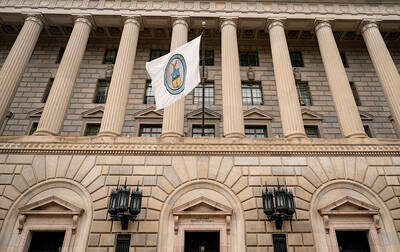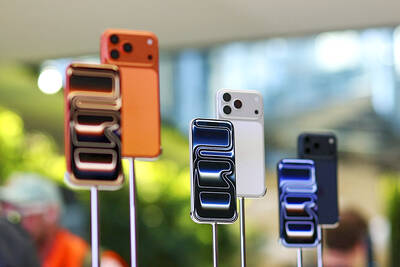When it comes to the world’s second-largest maker of memory chips, analysts and short sellers are poles apart.
A week after a spike in bearish bets caused the South Korean stock exchange to halt short-selling of SK Hynix Inc, analysts remain universally positive, with all 42 of those tracked by Bloomberg having a “buy”-equivalent rating on the stock.
So far, the bulls appear to have the upper hand. Since sliding in the wake of the short-selling rush, caused by an upsized convertible-bond issue, the stock has rebounded. Rival Samsung Electronics Co’s announcement last week that it is cutting chip production further padded those gains, which now stand at 20 percent on the year.

Photo: Reuters
As more production is taken offline, it could eventually “help the entire chip industry,” Yuanta Securities Korea Co analyst Baik Gilhyun said.
Results due in two weeks are set to shed light on the industry outlook, which has been aided by Samsung’s production curbs. While the cuts should help accelerate the recovery in the memorychip market, some investors fret that SK Hynix might have to follow suit.
“The demand in the industry — PC and mobile — is not so favorable,” Midas International Asset Management Co cochief executive officer Shin Jinho said.
Weak demand has created a supply glut for memory chips that has depressed prices. The backdrop is not helped by a combination of rising interest rates, surging inflation and a banking crisis that have dented consumer sentiment.
On Monday, Taiwan Semiconductor Manufacturing Co (TSMC, 台積電) said it missed sales estimates for a second consecutive quarter — a sign of continued weakness in global electronics demand.
TSMC lost 0.76 percent yesterday, closing at NT$520 after falling 0.95 percent on Tuesday, a day after the chipmaker reported its first-quarter sales of NT$508.63 billion (US$16.67 billion), which fell short of its guidance of NT$512.69 billion to NT$537.25 billion.
Most analysts are bullish on SK Hynix given that the memory market is expected to recover in the second half of this year as inventory pressures ease, and cuts in production and capital spending limit supply.
Daishin Securities Co analyst Wi Minbok said that there is a high probability that memorychip prices will rebound in the second half of this year.
“And I believe there will be a shortage in 2024,” he said.
Yet the company looks to be facing a tougher road than others. For one, the Apple Inc supplier is expected to post a net loss in each quarter of the 2023 fiscal year, analyst estimates compiled by Bloomberg showed.
In contrast, Samsung and TSMC are set to stay in the black all year.
While SK Hynix’s shares have risen alongside technology stocks more broadly this year, they are still 38 percent below their 2021 peak as the company works through an outsized amount of inventory following its acquisition of Intel Corp’s flash memory business.
The stock is priced at 2.4 times sales projected over the next 12 months, greater than an average of 1.7 times over the past decade, data compiled by Bloomberg showed.
The key to the stock’s immediate performance is likely to be in the upcoming results announcement.
One should “pay more attention to further announcements on production cuts rather than short-term sluggish performance,” Baik said.
Additional reporting by CNA

Taiwan’s foreign exchange reserves hit a record high at the end of last month, surpassing the US$600 billion mark for the first time, the central bank said yesterday. Last month, the country’s foreign exchange reserves rose US$5.51 billion from a month earlier to reach US$602.94 billion due to an increase in returns from the central bank’s portfolio management, the movement of other foreign currencies in the portfolio against the US dollar and the bank’s efforts to smooth the volatility of the New Taiwan dollar. Department of Foreign Exchange Director-General Eugene Tsai (蔡炯民)said a rate cut cycle launched by the US Federal Reserve

The US government on Wednesday sanctioned more than two dozen companies in China, Turkey and the United Arab Emirates, including offshoots of a US chip firm, accusing the businesses of providing illicit support to Iran’s military or proxies. The US Department of Commerce included two subsidiaries of US-based chip distributor Arrow Electronics Inc (艾睿電子) on its so-called entity list published on the federal register for facilitating purchases by Iran’s proxies of US tech. Arrow spokesman John Hourigan said that the subsidiaries have been operating in full compliance with US export control regulations and his company is discussing with the US Bureau of

Businesses across the global semiconductor supply chain are bracing themselves for disruptions from an escalating trade war, after China imposed curbs on rare earth mineral exports and the US responded with additional tariffs and restrictions on software sales to the Asian nation. China’s restrictions, the most targeted move yet to limit supplies of rare earth materials, represent the first major attempt by Beijing to exercise long-arm jurisdiction over foreign companies to target the semiconductor industry, threatening to stall the chips powering the artificial intelligence (AI) boom. They prompted US President Donald Trump on Friday to announce that he would impose an additional

Pegatron Corp (和碩), a key assembler of Apple Inc’s iPhones, on Thursday reported a 12.3 percent year-on-year decline in revenue for last quarter to NT$257.86 billion (US$8.44 billion), but it expects revenue to improve in the second half on traditional holiday demand. The fourth quarter is usually the peak season for its communications products, a company official said on condition of anonymity. As Apple released its new iPhone 17 series early last month, sales in the communications segment rose sequentially last month, the official said. Shipments to Apple have been stable and in line with earlier expectations, they said. Pegatron shipped 2.4 million notebook